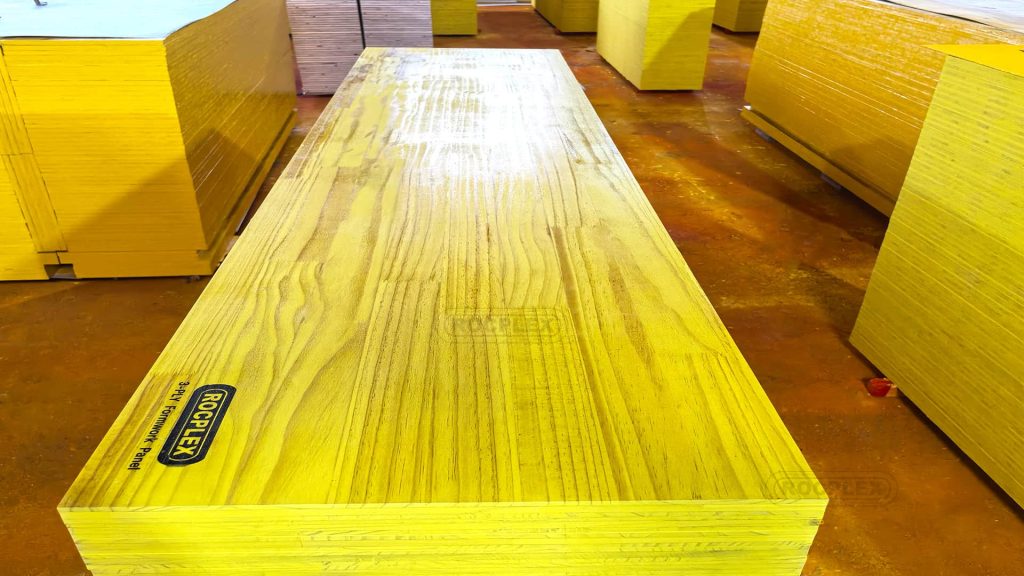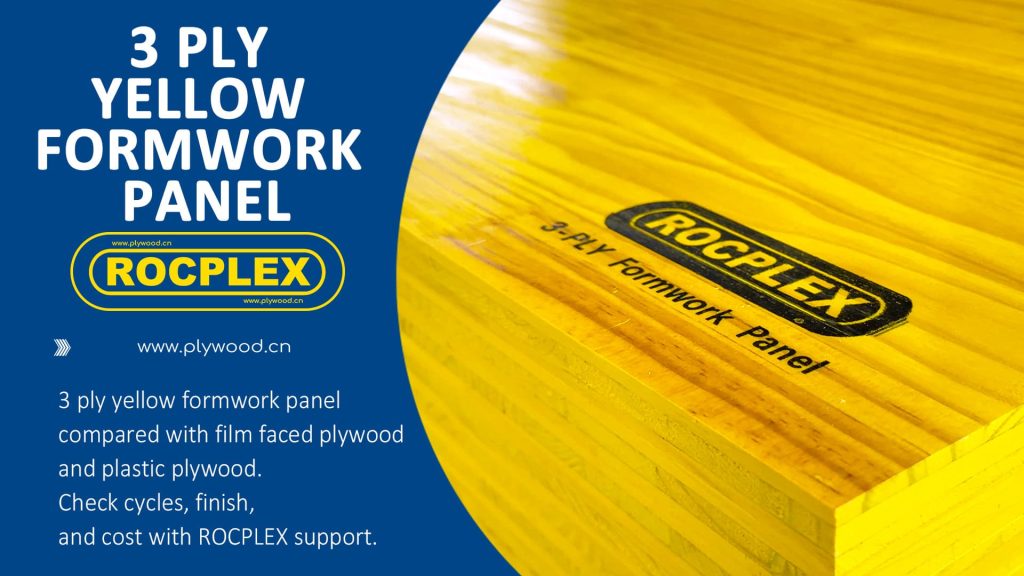3 ply yellow formwork panel overview
Contractors value stable forms. Crews need fast stripping. Owners want fair faces. A three-layer build answers all three. The crosswise core controls width movement. Dense outer lamellae carry bending stress. A tough coating resists abrasion and water. ROCPLEX 3 Ply Yellow Formwork Panel holds tight tolerances for each batch.
Why compare with film faced plywood
Film faced plywood remains common. Supply is wide and pricing looks attractive. However, core gaps can telegraph on faces. Thin films scratch under harsh cleaning. Edges also chip sooner with rough handling. Three-layer solids resist those issues better. You see fewer patch spots after stripping.

Why compare with plastic plywood
Plastic plywood cleans quickly after pours. It shrugs off water and mud. Yet some faces feel slick under boots. Certain oils also reduce grip during placement. Edge chips still happen from impacts. A 3 ply yellow formwork panel balances grip and release. ROCPLEX tunes the face for predictable feel.
3 ply yellow formwork panel structure
Three solid layers form the panel. The middle layer runs across the grain. That layout stabilizes the sheet under pressure. Outer layers add wear and stiffness. Bond lines set long-term strength. A durable topcoat completes the system. Together, they protect geometry and finish.
Materials and bonding that lift cycles
Species selection sets weight and stability. Moisture arrives within a tight window. Glue spread stays even across the layup. Heat and pressure complete the cure. ROCPLEX tracks those values by batch. The process delivers consistent reuse counts. Your crews feel that reliability on day two.
Thickness and deflection planning
Span and pressure decide thickness. 21 mm suits close centers and light work. 27 mm reduces sag on wider centers. Triply panel 27mm targets tall cores and tanks. Many yards stock both thicknesses. That mix covers decks and walls. Smoother planning follows that choice.
Surface finish and fair-faced targets
Finish sells your work. Even texture wins repeat projects. Clean oil spreads in a thin film. Tight joints reduce air pockets. Stripping then leaves fewer marks. ROCPLEX coats print with steady tone. Patching time drops across floors and lifts.
Edge sealing and moisture control
Edges fail first without care. Forks and clamps hit them all day. Factory sealing slows water ingress. Chips still appear on tough sites. Re-seal scuffs immediately. Five minutes now saves many pours. Crews learn this habit quickly.
Handling, ergonomics, and safety
Teams lift sheets many times daily. Predictable weight protects backs and speed. Accurate sizes reduce awkward cuts. Balanced density keeps carries steady. Crews stay focused on placement. ROCPLEX controls weight bands by species. That control improves safety and tempo.
3 ply yellow formwork panel System fit and compatibility
Panels must fit beams, walers, and clamps. Straight edges clamp tight and seal joints. Consistent thickness stabilizes clamp pressure. Flat sheets align faster with fewer shims. System fit then speeds the pour window. ROCPLEX verifies flatness before loading.
Film faced plywood strengths and limits
This option offers fast availability. It also matches many formwork systems. However, cycle counts vary by core quality. Thin films scratch under gritty rags. Face repair then consumes time and money. Choose it for short runs and simple pours. Select solid three-layer panels for longer sequences.
Plastic plywood strengths and limits
Plastic faces resist water and concrete fines. Cleaning runs fast with correct tools. However, release oil choice matters a lot. Some blends reduce traction during placement. Edges still bruise under sharp clamps. Test oil on a small area first. Train crews on safe footing.
3 ply yellow formwork panel Cost per pour beats price alone
Sheet price hides the full story. Count reuses, labor, and finish time. Add defects and schedule risks. Include claims and re-delivery costs. A better panel lowers those totals. ROCPLEX shares a simple cost model. Decisions then follow real math, not guesses.

3 ply yellow formwork panel field gains
Foremen report cleaner releases. Joint lines stay tight with steady edges. Corners hold shape during repeat pours. Crews strip earlier across long days. Finish teams arrive with lighter loads. These small gains stack across weeks. Schedules breathe as delays shrink.
Sustainability and reuse value
Reuse reduces waste and cost. Fewer sheets reach landfill over months. Responsible forests add value to bids. Efficient pressing also cuts mill waste. Accurate cutting reduces site offcuts. ROCPLEX invests across that chain. Projects benefit from that discipline.
ROCPLEX quality controls that matter
We track veneer moisture at intake. Glue spread remains calibrated per lane. Press time and temperature follow recipes. Coating weight stays uniform on both faces. Edges receive full sealing at the mill. Thickness and flatness sit in tight bands. Every batch carries traceable data.
People also ask: quick answers
What is a 3 ply yellow formwork panel?
It is a solid-wood form panel with three layers. The core runs crosswise for stability.
How many reuses can I expect?
Care, coating, and climate set the number. Good routines push counts higher.
Is it better than film faced plywood?
Often yes on repeat work. Solid cores resist movement and edge loss.
Can I cut panels on site?
Yes. Use sharp blades on clean tables. Re-seal edges after each cut.
Which oil should I choose?
Use oils approved for your face coat. Apply thin and even each shift.
How do I stop honeycombing?
Keep edges square and tight. Clean, oil, and clamp with consistent pressure.
Care routine that protects cycles
Clean the face after each strip. Use soft scrapers, not steel blades. Avoid gritty rags and dirty oil. Stack dry and shaded on dunnage. Cover bundles from sun and rain. Re-seal edges after chips and cuts. Small habits deliver large cycle gains.
Weather and stripping considerations
Heat tests bonds and coatings. Quality bonds hold through hot afternoons. Cold slows chemical reactions in concrete. Strip times may change by hour. Monitor conditions and adjust oils. Record settings for the next deck. Your results improve with notes.
Logistics for wholesalers and yards
Bundles must travel far without damage. Corner guards protect edges in transit. Straps hold firm without crushing layers. Labels face aisles for quick picks. Mixed thickness packs serve varied orders. Fork pockets suit common equipment. Loading then runs faster and safer.
Procurement checklist before ordering
Confirm species and glue system. Check coating weight and curing. Verify thickness tolerance and flatness. Ask for edge sealing details. Match sizes to your grid and clamps. Request batch QC sheets and photos. Plan storage covers and handling gear.
Case uses across project types
Basements need clean fair faces. Parking decks require quick stripping between pours. High-rise cores demand predictable cycles. Tanks need tight joints under pressure. 3 ply yellow formwork panel suits many roles. Film faced plywood covers short runs. Plastic plywood helps in wet zones.
Estimating cycle life with records
Start with a baseline by product. Adjust for climate and crew habits. Track cycles by bundle ID and site. Note oil type and cleaning tools. Share weekly charts with the team. Recognition builds stronger routines. The data also supports bids and claims.
Risk management and common mistakes
Do not over-oil faces. Excess oil grabs fines and stains. Do not use contaminated oil. It softens coats and hurts release. Do not stack on wet ground. Moisture creeps into edges quickly. Fix chips early and often. Each rule protects cycles and morale.
3 ply yellow formwork panel vs three ply shuttering panel
Names sometimes confuse buyers. Structure stays similar across markets. Solid lamellae define both choices. ROCPLEX keeps variables tight across lines. You then see repeat results across containers. Focus on specs, not labels alone.
3 ply yellow formwork panel vs concrete formwork boards
Generic boards hit low prices. However, flatness may drift over time. Moisture control also varies by mill. Edges chip earlier under heavy use. Three-layer solutions reduce those risks. Geometry holds longer under pressure. Finish quality then remains more stable.
Training that sticks with new crews
Hold a toolbox talk before first use. Show release oils and spray patterns. Demonstrate soft scrapers and safe angles. Explain why edge repair matters. Post a care chart near storage racks. Celebrate teams that add reuse counts. Culture grows from small wins.
ROCPLEX 3 ply yellow formwork panel advantages
Coats resist abrasion in daily work. Sealed edges defend corners in transit. Tight thickness control speeds clamping. Flatness holds across large faces. Crews feel that consistency from day one. Claims fall when panels behave.
Comparing at a glance
- 3 ply yellow formwork panel: balance of speed and stability.
- Film faced plywood: wide supply; cycle counts vary.
- Plastic plywood formwork: water-resistant; check traction and oil.
- Triply panel 27mm: stiffness for tall pours and spans.
- Three ply shuttering panel: geometry focus for mixed tasks.

Choose ROCPLEX 3 ply yellow formwork panel and request samples with a cost-per-pour quote
Choose panels by cycles, finish, and time. Evaluate coating weight and edge sealing. Track costs beyond sheet price. Consider crew habits and climate. ROCPLEX 3 ply yellow formwork panel offers a strong match. Ask for samples and a cost-per-pour model. Let’s help your crews pour, strip, and repeat with confidence.

Formwork Plywood
Formwork plywood, also known as formply, shuttering plywood, or film faced plywood. It is a durable and versatile material used in concrete formwork and other construction applications.
What is Formwork plywood?
Formwork plywood is specifically designed for use in concrete formwork, providing a smooth, uniform, and durable surface that can withstand the harsh conditions encountered in construction projects. The surface of formply is smooth and non-porous, reducing the need for additional finishing work and saving time and costs.
Formwork construction film faced plywood is made from layers of hardwood or softwood veneers bonded together with strong, moisture-resistant adhesives like phenolic or melamine resin. This engineered construction offers excellent strength, rigidity, and durability, making it capable of withstanding heavy loads and repeated use.
Advantages of Formwork plywood.
One of the significant advantages of formply is its water and chemical resistance. Treated with water-resistant and chemical-resistant coatings. It can maintain its structural integrity even when exposed to harsh elements found on construction sites.
Shuttering plywood is also reusable, making it a cost-effective option for construction projects. With proper care and maintenance, it can be used multiple times, reducing waste and minimizing costs.
Construction use shuttering plywood has various applications in the construction industry, including concrete formwork, wall and column shuttering, slabs and beams, and temporary structures like scaffolding and exhibition booths.
Formwork plywood is a versatile, durable, and cost-effective solution for construction projects. Its strength, water resistance, and reusability make it a popular choice for concrete formwork and other applications.
Formwork plywood is available in a range of sizes and thicknesses to suit various construction needs. It can be easily cut to size and shaped according to the specific requirements of the project. This versatility makes it a popular choice among contractors and builders who require customized solutions for their construction projects. Whether it is for building foundations, walls, columns, slabs, or temporary structures, formwork plywood is a reliable and cost-effective option that provides excellent performance and durability.
Post time: Nov-05-2025

